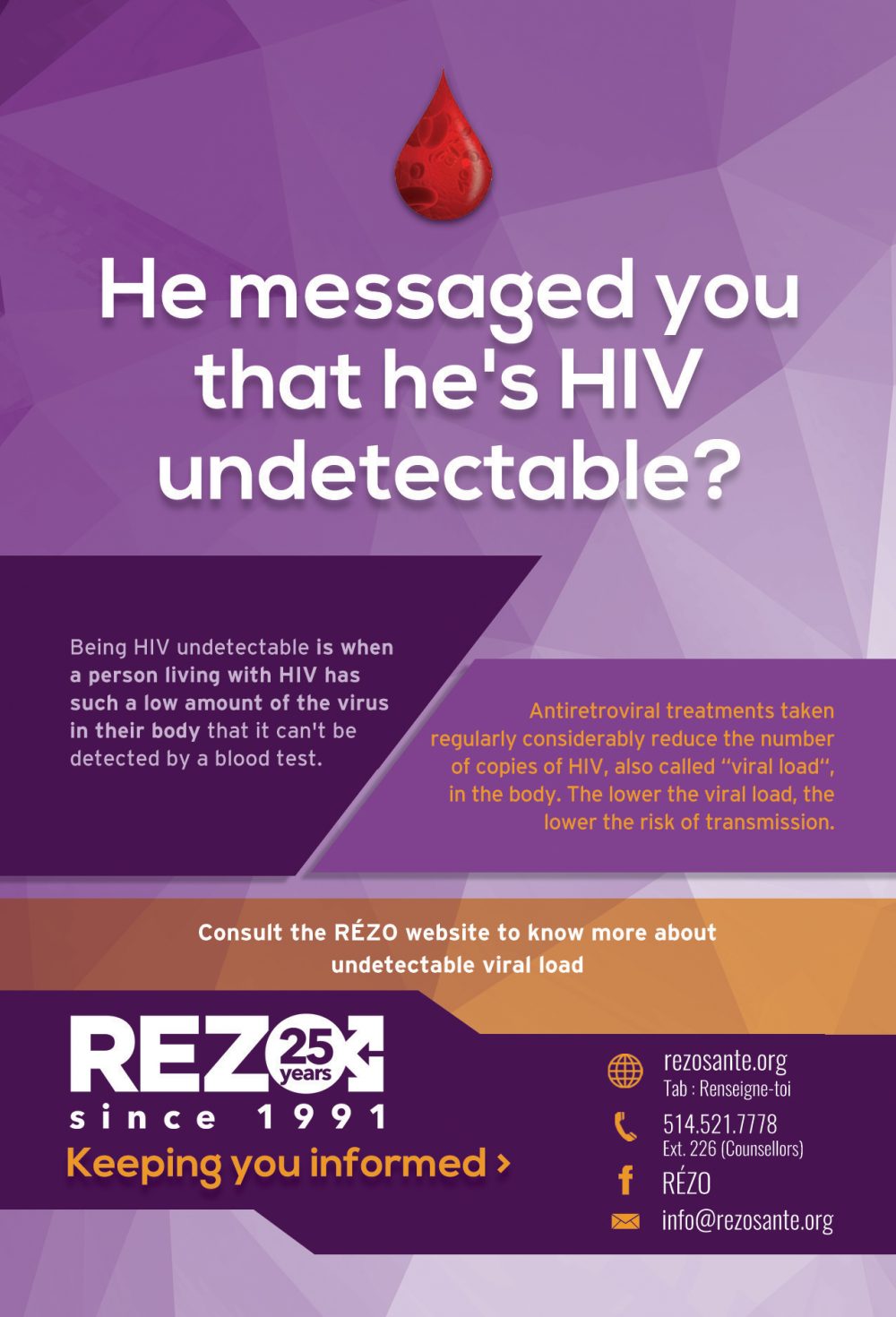What is a viral load?
The viral load is a way to measure the number of copies or molecules of a virus present in the body of a person infected with HIV. It is generally measured by a blood sample: it allows a monitoring of the health of a person carrying the virus and their response to treatment. Once a person is HIV positive (or carrier of the HIV virus), the virus multiplies in the body of that person (blood, sperm, mucus membranes, etc.). The higher the viral load of a person, the higher the risk of complications related to the presence of HIV in the body: a lower functioning of the immune system and the appearance of opportune infections that take advantage of the weakened immune system. An accumulation of these different factors can lead to the phase of AIDS.
What does it mean to have an undetectable viral load?
For a person living with HIV, having an undetectable viral load means two things: avoiding the development of complications related to HIV and avoiding the risk of transmitting the virus to an HIV negative person during a sexual encounter. To have an undetectable viral load, the infected person must follow precisely their antiretroviral treatment. Keep in mind that an HIV positive person must have regular follow-ups with their primary care physician. During these visits, the doctor will take blood samples to check the viral load of their patient and to ensure a proper treatment (antiretroviral) and make any required adjustments.
A person taking an Antiretroviral Therapy (ART) and who is responding well to their treatment will see their viral load lower significantly. In Canada, most medical laboratories can detect the viral load of HIV starting from 40 copies of the virus per millilitre of blood. Anything lower then this point, it is said that the viral load is undetectable (U=U, Undetectable = Unstransmittable).
What are the risks of becoming infected by a person with an undetectable viral load?
The higher the number of copies of the virus in the blood system, the higher the risk of HIV transmission. Inversely, a lower viral load reduces significantly the risks of transmission.
According to a consensus of experts of the Institut national de santé publique du Québec (INSPQ, May 2014), an undetectable viral load (lower than 40 copies per ml) reduces the risk of HIV transmission during oral, vaginal or anal sex where a condom is not used. This risk of transmission goes from a high level to a negligible or very low level when the six following conditions are consistently met:
- An undetectable viral load is maintained for at least 6 months (with 2 blood test during this time period), due to effective ART (antiretroviral therapy);
- At least 95% treatment adherence (following the treatment precisely, taking the proper amounts at the proper time);
- Partners in a stable and exclusive couple;
- Confirmed absence of STBBIs (Sexually Transmitted and Blood-borne Infections) in both partners;
- A regular medical follow-up every 3 to 4 months, including measurements of the viral load and a STBBI screening for the person living with HIV and a STBBI screening, including HIV screening, for the HIV negative partner;
- Regular and appropriate counselling for both partners covering the above-mentioned conditions as well as risk reduction, including correct condom use.
Despite respecting these conditions, the opinions of experts still advise that there is no guarantee of zero risk. Some risk of transmission may remain, but it is much lower.
Once a person is undetectable, will it stay that way indefinitely?
Contrary to the beginning of the HIV epidemic, treatments have greatly evolved since. An HIV positive person with an undetectable viral load, who takes care of themselves and adheres properly to their treatment (taken regularly), can maintain an undetectable viral load for many years, and therefore their risk of transmitting HIV stays very low.
However, at certain times the viral load can increase, signifying that the virus has recommenced multiplying in the body. This increase in the viral load generally happens after contracting an infection, a virus, an STBBI or after stopping medication. Most of the time the viral load will once again become undetectable when the person’s health has been stabilized. In certain situations, a person will not be able to return to being undetectable. This happens, among other things, when the immune system has become resistant to the medication. With the advancements in treatments and variety available, physicians have at their disposition an array of medications that can counteract these resistances that a patient may develop. Thus, if the new medication works well, the viral load can return to undetectable.
Why can an undetectable viral load be seen as an HIV prevention strategy ?
Consideration of an undetectable viral load before a sexual encounter with a partner is an HIV prevention strategy. An HIV positive person with an undetectable viral load, who has a regular medical follow-up and who takes their antiretroviral treatment is at a lower risk of transmitting HIV then a person who does not know their HIV status.
What about other STBBIS (sexually transmitted and blood-borne infections)?
Even if we know that an undetectable viral load considerably reduces the risk of HIV transmission, don’t forget that there are still other STBBIs that you can catch. This is why condoms stay the most certain way to prevent catching an STBBI. To know more about different STBBIs, click here.
Do yout want to know more about viral load or talk about a specitic situation you are experiencing or have experienced?
Don’t hesitate to contact our counseling team here

More questions?
Source material consulted for this article and complimentary information: